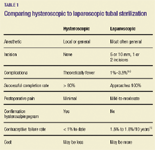Grand Rounds: An update on hysteroscopic tubal sterilization
Now that the device has been available in the United States for several years, there are more clinical data to look at. Here's a brief review of the literature on its indications, benefits, contraindications, and complications.

Conceptus Inc. (Mountain View, Calif.), the device manufacturer, states that there have now been more than 45,000 Essure procedures worldwide. According to data submitted to the FDA, at 4-year follow-up the procedure is 99.8% effective. Five-year data place it at 99.74% effectiveness. Conceptus predicts that when 2005 follow-up data are available, they will yield 99.8% effectiveness due to a larger sample of women completing 5 years of follow-up.1
When is the procedure indicated?
Tallying up the benefits

Until recently the only method of permanent sterilization available to American women (other than hysterectomy) has been tubal sterilization and it is that to which hysteroscopic sterilization must be compared to when considering the procedure's benefits.
[The combination of tubal sterilization and vasectomy account for 39% of contraceptive methods used by reproductive-aged patients (28% and 11%, respectively).3] Older studies have estimated mortality associated with tubal sterilization to be between one to four deaths per 100,000 cases. A more recent literature review reported no mortalities in 9,475 women undergoing interval laparoscopic tubal sterilization.4 Major complications involving female sterilization range from 1% to 3.5%.4-6 These include the complications of anesthesia, hemorrhage, infection, as well as gastrointestinal and urinary tract injury. Most complications result from the need for general anesthesia and to perform an intraabdominal procedure involving trochar placement through the abdominal wall and/or use of electrical energy sources to achieve tubal occlusion. Avoiding general anesthesia and laparoscopy or laparotomy should reduce these complications considerably.
